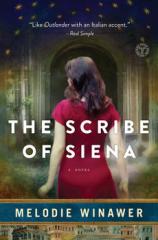The Scribe of Siena
Review
The Scribe of Siena
Dr. Beatrice Trovato, a talented and overworked New York City neurosurgeon, experiences a feeling during surgery that her patient will become hypoxic. She reacts quickly to alert her anesthesiologist, Linney. Afterward, at lunch, she confesses to Linney that “I felt like I couldn’t breathe…but I knew it was the patient…I just knew.” Agreeing that she needs more rest, Beatrice tries to forget the incident.
A second “in-another-person’s-head” experience makes Beatrice think seriously of taking time away from her unrelenting surgery schedule. Her brother, Ben, lives in Siena, Italy, where his reputation for research on medieval history is well known. His expertise centers on the Plague of the mid-1300s and its deadly effect on Siena. Orphaned at a young age, the two became close. Beatrice supports him, misses their interaction and decides to travel to Italy.
She renews her passport, buys a ticket and makes preparations for the trip. But a letter from Ben’s lawyer reveals that Ben has passed away, the victim of a heart attack. She has inherited his house, his research documents and his belongings. A grief-stricken Beatrice plans for a three-month sabbatical from her job.
"For the historical fiction reader who may not be interested in time-travel stories, THE SCRIBE OF SIENA has the ability to draw one completely into the settings, both present and distant past."
THE SCRIBE OF SIENA is written in first person, giving the reader immediate access to Beatrice’s inner thoughts, her initial reactions to events, and how she will formulate methods to find answers to her many questions. When she does have an otherworldly experience, one is alongside her in the activity. Debut novelist Melodie Winawer, herself a neurosurgeon, interjects details of medical practices and terminology into the plot. One accepts the fruit of her knowledge without question.
When the packet of Ben’s research notes arrives, Beatrice studies his hypothesis and vows to complete the manuscript for publication. According to his notes, the biggest question remains why Siena, a thriving city filled with artistic accomplishments and cultural promise, was devastated and broken by the Black Death of 1348, while other cities in Tuscany were stricken but not wiped out. Beatrice is determined to find the answer.
Once moved into her new Italian residence, Beatrice sorts through Ben’s papers and discovers a parchment piece, a letter written by a Florentine woman to her cousin, Salvestro de’Medici. Señora Medici has grave concerns for her son, whose melancholy will not leave him following his father’s execution. The correspondence is dated September 1347. What was Ben doing with the piece? Beatrice decides to chart the players Ben has researched, along with dates and places, to better understand his search. The lawyers tell her that a number of historical researchers want to complete Ben’s work for publication. One in particular, Señor Signoretti, is adamant in his quest. Why?
Beatrice has met her close neighbors, the Guerrini family. Donata, the mother of three children, is an art historian at the University of Siena. The two women become fast friends and confidants. Beatrice shares coffee with her one day, following Donata to the Piazza del Duomo, where Donata points out special art going back to the 1300s. At one time, there were reported to be five frescos depicting the life of the Virgin Mary, including one of her ascension. The first frescos are attributed to a famous painter, but the last might be from his apprentice.
Later, researching in a quiet cubicle in the library, Beatrice discovers a diary written by a Siena resident during the same time period. The words compel her to delve into the life of artist Gabriele Beltrano Accorsi. When she returns to view the artistic site, odd moments assault her to seek quiet in the empty chapel. There, a trancelike state overwhelms her. Transported to Siena in 1347, Beatrice begins to live out the story of the artwork when she meets Gabriele in person. She has known him through his writings, but now his reality sets in.
For the historical fiction reader who may not be interested in time-travel stories, THE SCRIBE OF SIENA has the ability to draw one completely into the settings, both present and distant past. The rich period cultures, past and present, are seen relative to each other. Beatrice’s mission to publish her brother’s treatise on Siena finds her beset with numerous complications, the biggest one being her journey backwards, and she must rely on help from both modern and historical friendships. Beatrice lives in two worlds, making profound relationships in two time frames while solving a quirky historical mystery and meeting her destiny. THE SCRIBE OF SIENA is an impressive first novel from a talented writer.
Reviewed by Judy Gigstad on June 16, 2017
The Scribe of Siena
- Publication Date: January 2, 2018
- Genres: Fiction, Historical Fiction
- Paperback: 480 pages
- Publisher: Touchstone
- ISBN-10: 1501152262
- ISBN-13: 9781501152269





